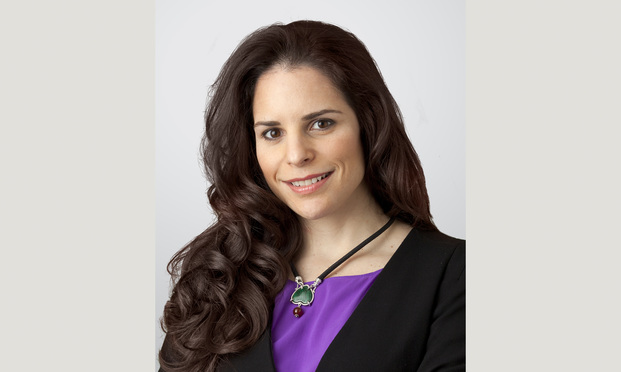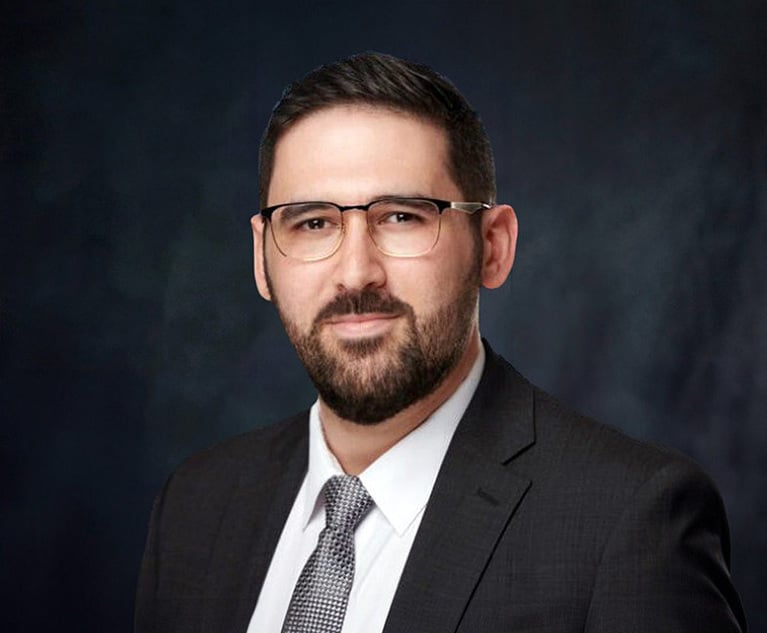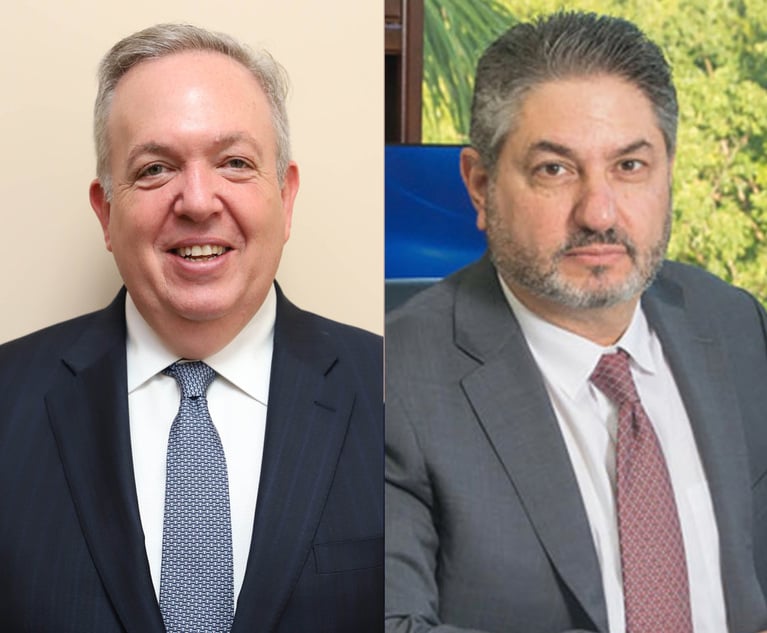Ready, Set, Zoom—A Close Up Look at a Virtual Evidentiary Hearing
Over the past two decades, I have handled my fair share of telephonic depositions, mediations and hearings in state, federal and bankruptcy courts.…
April 28, 2020 at 01:15 PM
5 minute read
 Annie Gamez, partner with Holland & Knight in Miami.
Annie Gamez, partner with Holland & Knight in Miami.
Over the past two decades, I have handled my fair share of telephonic depositions, mediations and hearings in state, federal and bankruptcy courts. However, if you would have told me a month ago that I would be conducting a two-day final evidentiary hearing in federal court via Zoom with the court, counsel, parties and witnesses appearing virtually from various locations in South Florida and Guatemala, I would not have believed you.
Five years ago, I represented a Nicaraguan company in a week-long final arbitration hearing in New York. We had several witnesses testify via video conference from New Zealand and Nicaragua, including some requiring translations from Tagalog and Spanish. And then, three weeks before our firm shifted to remote operations, I represented a South Korean client in both a virtual deposition and mediation again dealing with another time zone and language. My client's virtual appearance at both of those proceedings required a court order, logistical planning with the court reporter's offices in Miami and South Korea, the mediator's office, a local translator and significant cooperation with opposing counsel.
When I volunteered to take on the pro bono representation of a Guatemalan mother sued for the return of her minor son a month ago, I did not anticipate that the Hague Convention's requisite expedited adjudication would be a virtual adjudication. Ten days into the representation, we attended our first virtual pretrial conference via the Southern District of Florida's Cisco Jabber platform, and encountered an intolerably distracting echo each time counsel spoke. Opposing counsel also informed us that his client and witnesses located in Guatemala would likely only be able to appear telephonically. For a moment, I was panic-stricken contemplating how this trial would play out under these unusual and challenging circumstances. Thankfully, those internal alarm bells rung much lower the following week when we held our second pretrial conference—this time over the court's newly acquired Zoom platform.
This time, I was armed with a more detailed checklist full of logistical questions and considerations that required discussion and agreement with the court, its IT staff and opposing counsel. We had to address everything from the seemingly trivial—whether counsel and witnesses could use a headset and access exhibits on their mobile devices, the location of the interpreters; the more critical, like the swearing-in of witnesses, filing of exhibits; to more tech-focused questions such as whether we could use the "screen-share" function on Zoom to help witnesses and the court follow along with an exhibit.
Once we worked out those details, my team's attention then turned to coordination with our own IT staff and witnesses. I personally spent a few hours testing access and use of Zoom and exhibits with both a local witness, and another located in Guatemala. We also had to work out the logistics within our Miami office so that we could set up our trial team, client and witness there in a socially distant way.
I finally met the client in person the morning of the first day of the hearing; all prior communication had been by phone and WhatsApp. All trial preparations with our supervising pro bono partner, two associates and paralegal were done via Zoom. Once the hearing commenced, we had to resolve a few logistical and procedural hiccups. First, we had no idea that Zoom had a special language feature that would have made it possible for persons to hear the interpreter speak only in their preferred language—Spanish or English (unfortunately, since the firm's version of the software did not have this feature, we were unable to use it during the proceedings).
Second, we had to figure out a convenient and nondisruptive method to "pass notes" among the trial team, which was spread out in our boardroom over two parallel 36-feet conference tables. Third, we utilized one laptop per lawyer and witness with a speakerphone acting as the dedicated microphone to maximize speaker visibility and minimize background noise. Fourth, we had to ensure that the witnesses appearing virtually from Guatemala that were all in the same two-room apartment with the petitioner were sequestered during the hearing.
Some of these details may seem inconsequential or would have been a nonissue when conducting a live trial, but they became ever so important when venturing into the new reality of a virtual trial. As the first day went on, we all got more adept at muting our respective lines when not speaking to avoid background noise and echo, accurately describing exhibits to make it easy for witnesses to locate, using the chat function with the court's IT personnel to resolve sporadic issues, and ensuring the interpreters were fully translating questions and testimony. By the time we concluded in the mid-afternoon the following day, it felt like "old hat."
Annie Gamez is a litigation and real estate partner in Holland & Knight's Miami office and a member of the firm's South Florida litigation team.
This content has been archived. It is available through our partners, LexisNexis® and Bloomberg Law.
To view this content, please continue to their sites.
Not a Lexis Subscriber?
Subscribe Now
Not a Bloomberg Law Subscriber?
Subscribe Now
NOT FOR REPRINT
© 2025 ALM Global, LLC, All Rights Reserved. Request academic re-use from www.copyright.com. All other uses, submit a request to [email protected]. For more information visit Asset & Logo Licensing.
You Might Like
View All
Conversation Catalyst: Transforming Professional Advancement Through Strategic Dialogue
5 minute read
SEC Whistleblower Program: What to Expect Under the Trump Administration
6 minute read
Turning the Shock of a January Marital Split Into Effective Strategies for Your Well-Being
5 minute read
Law Firms Mentioned
Trending Stories
Who Got The Work
J. Brugh Lower of Gibbons has entered an appearance for industrial equipment supplier Devco Corporation in a pending trademark infringement lawsuit. The suit, accusing the defendant of selling knock-off Graco products, was filed Dec. 18 in New Jersey District Court by Rivkin Radler on behalf of Graco Inc. and Graco Minnesota. The case, assigned to U.S. District Judge Zahid N. Quraishi, is 3:24-cv-11294, Graco Inc. et al v. Devco Corporation.
Who Got The Work
Rebecca Maller-Stein and Kent A. Yalowitz of Arnold & Porter Kaye Scholer have entered their appearances for Hanaco Venture Capital and its executives, Lior Prosor and David Frankel, in a pending securities lawsuit. The action, filed on Dec. 24 in New York Southern District Court by Zell, Aron & Co. on behalf of Goldeneye Advisors, accuses the defendants of negligently and fraudulently managing the plaintiff's $1 million investment. The case, assigned to U.S. District Judge Vernon S. Broderick, is 1:24-cv-09918, Goldeneye Advisors, LLC v. Hanaco Venture Capital, Ltd. et al.
Who Got The Work
Attorneys from A&O Shearman has stepped in as defense counsel for Toronto-Dominion Bank and other defendants in a pending securities class action. The suit, filed Dec. 11 in New York Southern District Court by Bleichmar Fonti & Auld, accuses the defendants of concealing the bank's 'pervasive' deficiencies in regards to its compliance with the Bank Secrecy Act and the quality of its anti-money laundering controls. The case, assigned to U.S. District Judge Arun Subramanian, is 1:24-cv-09445, Gonzalez v. The Toronto-Dominion Bank et al.
Who Got The Work
Crown Castle International, a Pennsylvania company providing shared communications infrastructure, has turned to Luke D. Wolf of Gordon Rees Scully Mansukhani to fend off a pending breach-of-contract lawsuit. The court action, filed Nov. 25 in Michigan Eastern District Court by Hooper Hathaway PC on behalf of The Town Residences LLC, accuses Crown Castle of failing to transfer approximately $30,000 in utility payments from T-Mobile in breach of a roof-top lease and assignment agreement. The case, assigned to U.S. District Judge Susan K. Declercq, is 2:24-cv-13131, The Town Residences LLC v. T-Mobile US, Inc. et al.
Who Got The Work
Wilfred P. Coronato and Daniel M. Schwartz of McCarter & English have stepped in as defense counsel to Electrolux Home Products Inc. in a pending product liability lawsuit. The court action, filed Nov. 26 in New York Eastern District Court by Poulos Lopiccolo PC and Nagel Rice LLP on behalf of David Stern, alleges that the defendant's refrigerators’ drawers and shelving repeatedly break and fall apart within months after purchase. The case, assigned to U.S. District Judge Joan M. Azrack, is 2:24-cv-08204, Stern v. Electrolux Home Products, Inc.
Featured Firms
Law Offices of Gary Martin Hays & Associates, P.C.
(470) 294-1674
Law Offices of Mark E. Salomone
(857) 444-6468
Smith & Hassler
(713) 739-1250






